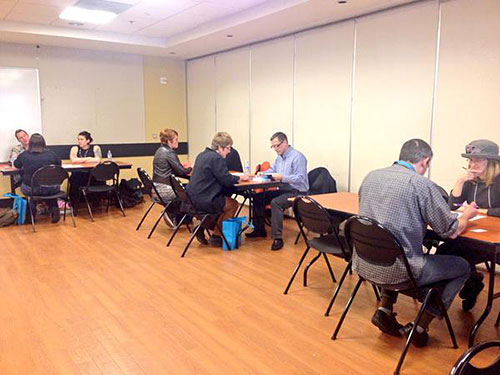As Ooligan’s Acquisitions team, we were honored to be asked to conduct the pitch workshop and participate in the pitch roundtable during this year’s Write to Publish. Authors are often confused about what is expected of them during the pitching opportunities at many writing conferences or other networking events. Though we designed the workshop to be a straightforward presentation on the things an author needs to be aware of when they consider pitching their manuscript, it was important that this also be a time for attendees to practice what they’d learned.
The workshop began with a short presentation that asked authors to place themselves in the shoes of the person to whom they’re pitching. If authors can learn to think about the things agents or editors are thinking about when they listen to a pitch, they can prepare a pitch that has that much more potential for success. This means considering things like the market and how the manuscript fits into it, as well as the timeliness of the subject matter.
After giving authors advice that boils down to “do your homework,” we broke down how to conduct two different types of pitches. The first is a longer-style pitch like the type authors would need in a five-minute pitch session, much like the one many of them would attend later during the pitch roundtable. The second is a short, one-sentence elevator pitch to have on hand when authors find themselves being asked, “What’s your book about?” by agents or editors they might find themselves mingling with during a conference or networking event. The examples we worked from were based on Ooligan’s recently acquired title, A Series of Small Maneuvers by Eliot Treichel.
Smoothly integrating the setting and setup, the conflict, a resolution, and a nod to the book’s potential audience is a difficult thing to do in one sentence, or even three. It takes time, patience, and a willingness to pare down an entire narrative to what is essential. To that end, we felt it was very important to give attendees ample time to practice. Everyone broke up into small groups to work on their own pitches and to offer feedback to their group mates. We made the rounds to answer questions and offer advice. It was encouraging to hear the constructive criticism that the authors offered each other; the opportunity for feedback from fellow writers is not one that comes around as often as many would like. That’s why we wanted to be sure authors had enough time to give thoughtful advice and gain confidence in their ability to present their manuscripts in the best possible light, no matter the circumstances.
The opportunity to host a pitch roundtable is also a rare one. It’s not often that we have the privilege of sitting down with authors, face-to-face, to hear their proposals. Although digital submissions are a godsend in the mere fact that they create a much-needed organizational system for a busy acquisitions editor, they unfortunately often contribute to a lack of transparency between publisher and author. Many writers spend countless hours crafting their proposals and cautiously weighing each and every word in a query letter only to send it out to some editor they know little or nothing about. The digital surface strips us of human connection and provides few opportunities for conversation to take place. It is also often not the most appropriate forum for an extensive conversation about expectations or the best space for extensive feedback to take place.
As much as many acquisitions editors would love the chance to engage in a lengthy conversation with each author, this quickly can get out of hand as the editor often has other functions in the publishing house as well. It is with efficiency in mind that we, like many other businesses, have certain guidelines and regulations in place when it comes to digital communication. In this light, conferences such as Write to Publish are things we look forward to every year because they allow us to shed our digital skins and appear in our rare human form to connect with local writers and authors.
As we sat down to listen to a variety of pitches and proposals, we noticed an overarching theme in our interactions—a desire for the elucidation of certain publishing practices and guidelines. Many authors, when finished pitching and listening to feedback, were curious about the internal workings of the industry and were able to freely ask any lingering questions they might have about the business, questions that never really properly fit in any window of query. Aside from being a great opportunity for prospective publishing, we think this observation speaks volumes about why writing and publishing conferences are great and important places: you get some face time with publishing professionals, and they are often very eager to demystify publishing. We had a great time at W2P, and we hope you did too!

